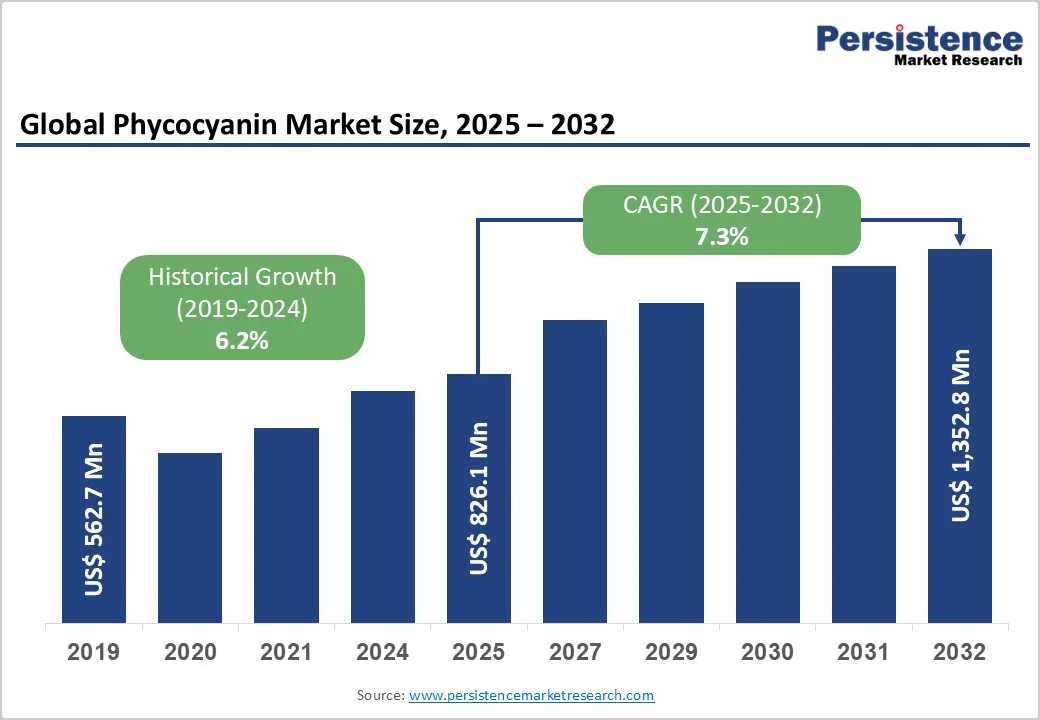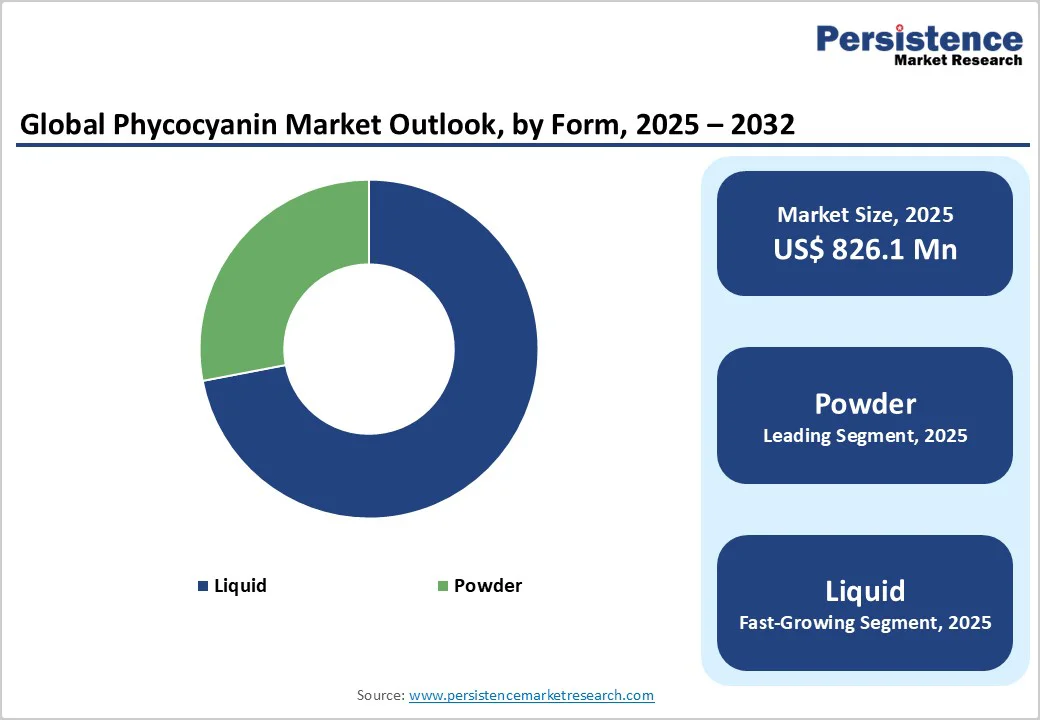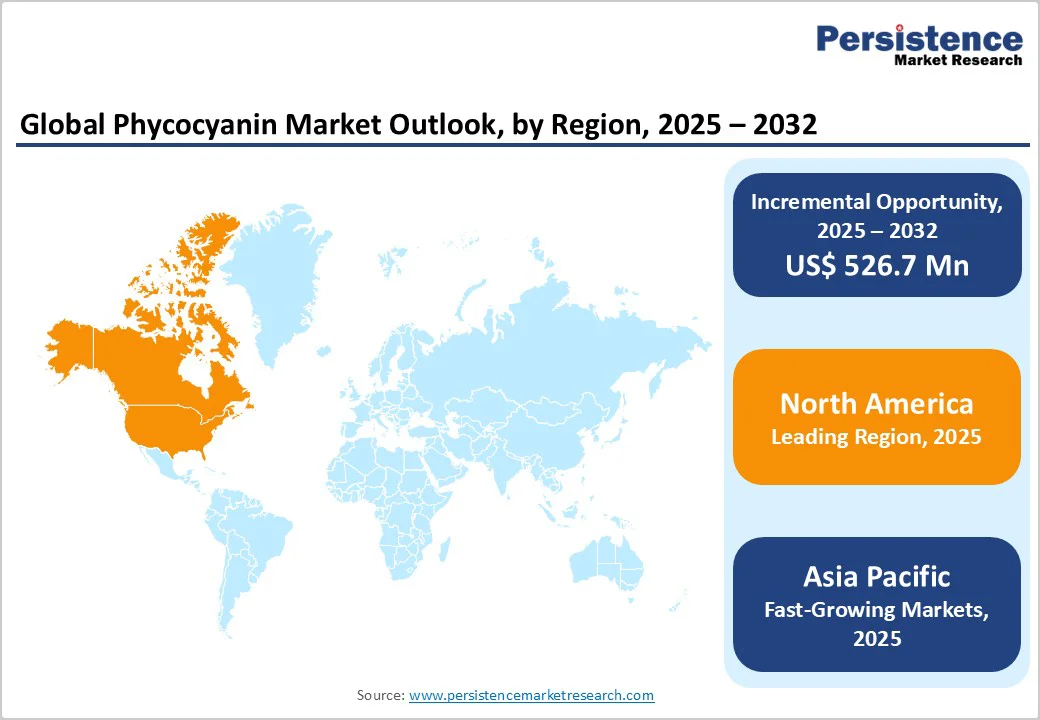ID: PMRREP32281| 199 Pages | 1 Dec 2025 | Format: PDF, Excel, PPT* | Food and Beverages

The global phycocyanin market size is valued at US$ 826.1 million in 2025 and projected to reach US$ 1,352.8 million at a CAGR of 7.3% during the forecast period from 2025 to 2032. Phycocyanin is emerging as a high-value natural colorant and functional ingredient, capturing attention across food, beverage, nutraceutical, and cosmetic applications. Its vibrant blue hue, antioxidant properties, and plant-based origin are driving adoption among health-conscious and clean-label-seeking consumers worldwide.
| Key Insights | Details |
|---|---|
|
Global Phycocyanin Market Size (2025E) |
US$ 826.1 Mn |
|
Market Value Forecast (2032F) |
US$ 1,352.8 Mn |
|
Projected Growth (CAGR 2025 to 2032) |
7.3% |
|
Historical Market Growth (CAGR 2019 to 2024) |
6.2% |

The surge in consumer preference for clean-label and plant-derived ingredients is propelling demand for phycocyanin across food, beverage, and nutraceutical applications. As awareness around synthetic colorants and chemical additives grows, manufacturers are turning to natural alternatives like phycocyanin, extracted from Spirulina, to meet evolving clean-label expectations. Its vibrant blue hue, combined with antioxidant and protein-rich properties, makes it an appealing choice for functional beverages, confectionery, and dietary supplements. Brands are leveraging phycocyanin to align with sustainability narratives, appealing to health-conscious and environmentally aware consumers. The trend toward plant-based diets, fortified foods, and visually appealing, naturally sourced formulations ensures phycocyanin remains a strategic ingredient for innovation, differentiation, and premium product positioning in global food and beverage portfolios.
High production costs associated with controlled Spirulina cultivation are placing a ceiling on large-scale price competitiveness in the phycocyanin market. Maintaining optimal light, temperature, pH, and nutrient conditions requires sophisticated photobioreactors or carefully monitored open-pond systems, which further drive energy, labor, and infrastructure expenses. Harvesting, dewatering, and extraction processes add further operational complexity, limiting the ability of producers to offer cost-effective solutions at an industrial scale. Small and medium-scale manufacturers face particular pressure as limited economies of scale amplify per-unit costs. This financial burden can slow adoption across price-sensitive industries such as beverages, confectionery, and nutraceuticals, and challenge new entrants seeking to compete with established suppliers capable of leveraging efficiency improvements and integrated cultivation-to-extraction operations.
Securing regulatory approvals in new regions is opening significant growth avenues for companies entering food-grade phycocyanin markets. As governments in North America, Europe, and parts of Asia establish clear guidelines for natural colorants, manufacturers can introduce Spirulina-derived Phycocyanin into beverages, confectionery, dairy, and nutraceutical applications with confidence. These approvals reduce compliance risk and accelerate product launches, allowing startups to penetrate high-value markets previously restricted by safety and labeling regulations. Established players can leverage this expansion to diversify portfolios and strengthen global supply chains, while tailoring formulations to meet local taste, stability, and processing requirements. Regional acceptance also encourages collaborative innovation in coloring solutions that align with clean-label and natural ingredient trends worldwide.
Powdered phycocyanin accounts for. 76% share as of 2025, reflecting its versatility, ease of storage, and extended shelf life that appeal to food, beverage, and nutraceutical manufacturers. Its concentrated form allows precise dosing, stable coloring, and easier transport across long supply chains, making it ideal for large-scale production and formulation consistency. Powdered phycocyanin is also preferred in dry mixes, bakery applications, and capsules where moisture sensitivity and stability are critical. Liquid phycocyanin, while less dominant, is gaining traction in ready-to-drink beverages, syrups, and functional drinks for its immediate solubility and vibrant color expression. Manufacturers are increasingly exploring liquid forms for premium, clean-label applications where visual impact and natural appeal drive consumer engagement.
Organic phycocyanin is projected to grow at a CAGR of 8.9% during the forecast period, driven by rising consumer preference for natural, clean-label ingredients in foods, beverages, and nutraceuticals. Its certification as organic assures buyers of sustainably cultivated Spirulina free from synthetic fertilizers and chemicals, enhancing trust and premium positioning. Organic phycocyanin is increasingly incorporated into health drinks, dietary supplements, and functional snacks, appealing to wellness-conscious consumers. Manufacturers are investing in controlled organic cultivation systems and scalable extraction processes to meet quality and purity standards. As global demand for plant-based, eco-friendly, and minimally processed colorants rises, organic phycocyanin offers companies a high-value, differentiation-focused product with strong growth potential across diverse application segments.

North America accounts for a 36% share in the global market, driven by strong adoption in functional foods, beverages, and nutraceuticals. In the U.S., rising consumer preference for natural colorants and clean-label ingredients is boosting demand for Spirulina-derived phycocyanin, with applications spanning energy drinks, protein powders, and dietary supplements. Canada is witnessing growth in organic and sustainable phycocyanin products, supported by health-conscious and eco-aware consumers. Leading brands such as Cyanotech Corporation, Earthrise Nutritionals, and Algatech are actively expanding production capacity and investing in advanced extraction technologies to deliver high-purity, stable phycocyanin. Innovation in powdered and encapsulated forms, combined with certifications for organic and non-GMO standards, is helping North American suppliers capture a premium market segment and enhance brand loyalty across the region.
Asia Pacific Phycocyanin Market is expected to grow at a CAGR of 8.5%, fueled by increasing demand for natural colorants and functional ingredients across food, beverage, and nutraceutical sectors. In China, manufacturers are expanding Spirulina cultivation and optimizing extraction processes to meet rising clean-label and organic product requirements. India is seeing startups and established players collaborating with research institutes to scale production of high-purity phycocyanin for energy drinks, dietary supplements, and bakery applications. Japan is focusing on premium-grade phycocyanin for cosmetics and health-oriented foods, while Southeast Asian countries are leveraging low-cost Spirulina biomass to produce both powdered and liquid formulations for regional and export markets. Investments in sustainable cultivation, R&D on stability enhancement, and certifications for organic and non-GMO standards are positioning the Asia Pacific as a critical hub for market expansion.

The global phycocyanin market exhibits a moderately fragmented structure, with established producers and agile startups competing to scale production and innovate high-purity, organic formulations. Leading companies are investing in advanced extraction and stabilization technologies, while expanding vertical integration from Spirulina cultivation to finished phycocyanin products. Startups are leveraging niche applications in functional foods, beverages, and cosmetics, often collaborating with research institutes to enhance yield, color stability, and bioactivity.
Rising demand for organic and non-GMO phycocyanin is driving certifications, sustainable cultivation practices, and eco-friendly processing. Product innovation spans powdered, liquid, and encapsulated formats, supported by R&D in enzymatic extraction, microfiltration, and light-sensitive packaging. Regulatory compliance, traceability, and partnerships across Asia Pacific, North America, and Europe strengthen competitive positioning and accelerate market growth.
The global phycocyanin market is projected to be valued at US$ 826.1 Mn in 2025.
Rising demand for clean-label and plant-derived ingredients is fueling the demand for Phycocyanins in the global market.
The global Phycocyanin market is poised to witness a CAGR of 7.3% between 2025 and 2032.
A significant market opportunity exists as regulatory approvals in new regions enable companies to expand into the food-grade color segment.
Major players in the global Phycocyanin market include DDW Inc., Sensient Technologies Corp., GNT Holding B.V., DIC Corporation, Naturex S.A., Cyanotech Corp, and others.
| Report Attribute | Details |
|---|---|
|
Historical Data/Actuals |
2019 - 2024 |
|
Forecast Period |
2025 - 2032 |
|
Market Analysis |
Value: US$ Mn |
|
Geographical Coverage |
|
|
Segmental Coverage |
|
|
Competitive Analysis |
|
|
Report Highlights |
|
By Nature
By Form
By End-user
By Region
Delivery Timelines
For more information on this report and its delivery timelines please get in touch with our sales team.
About Author